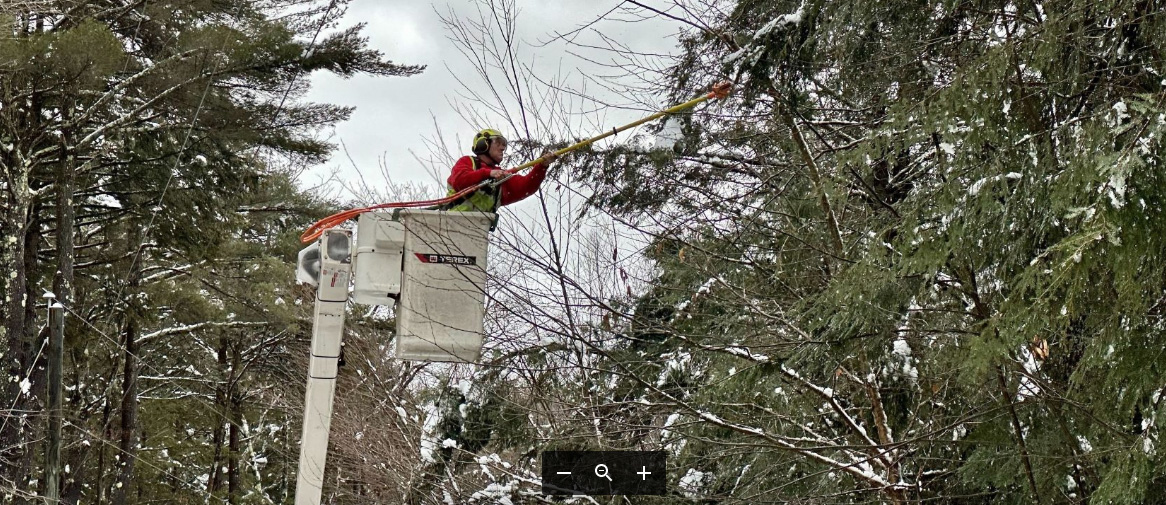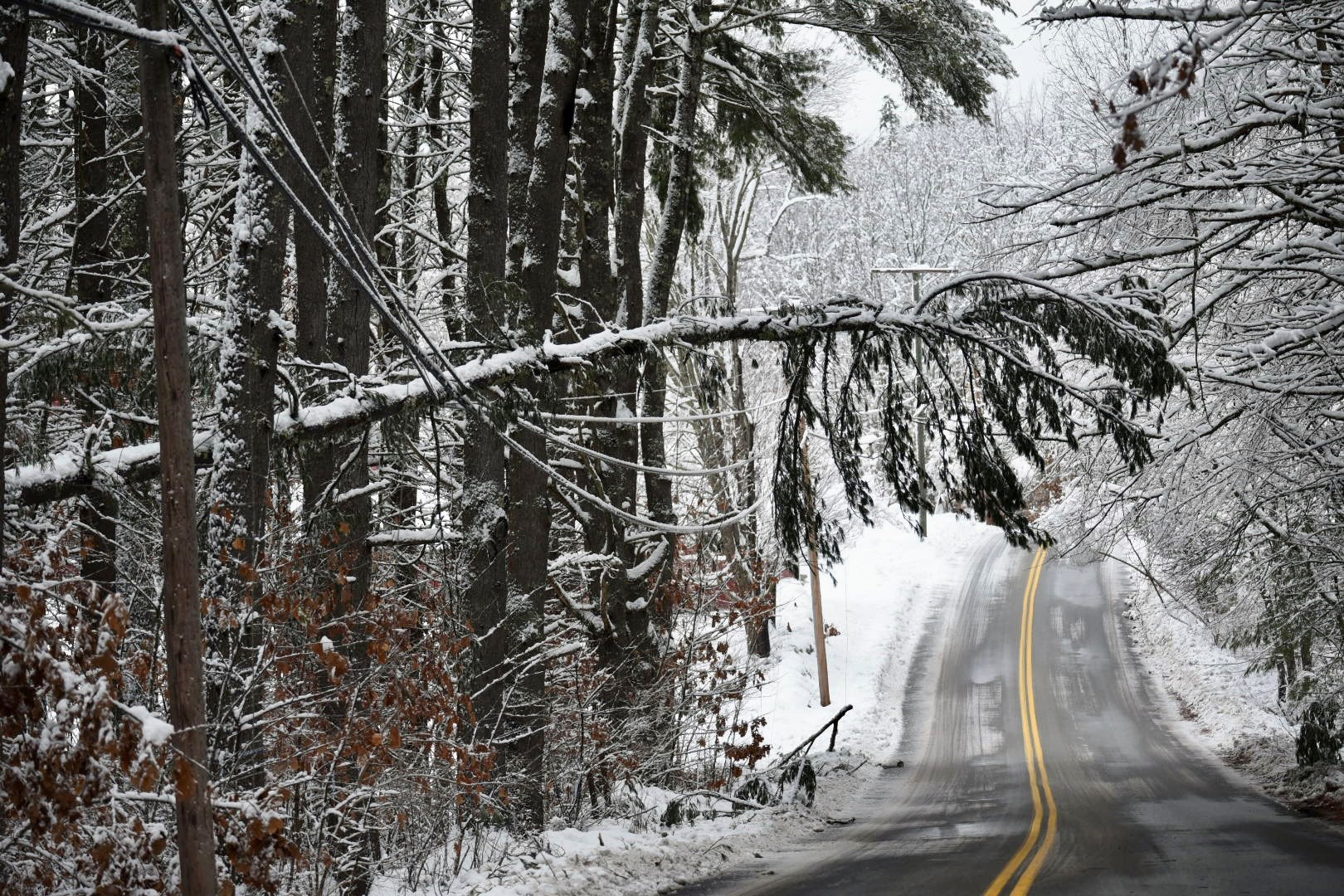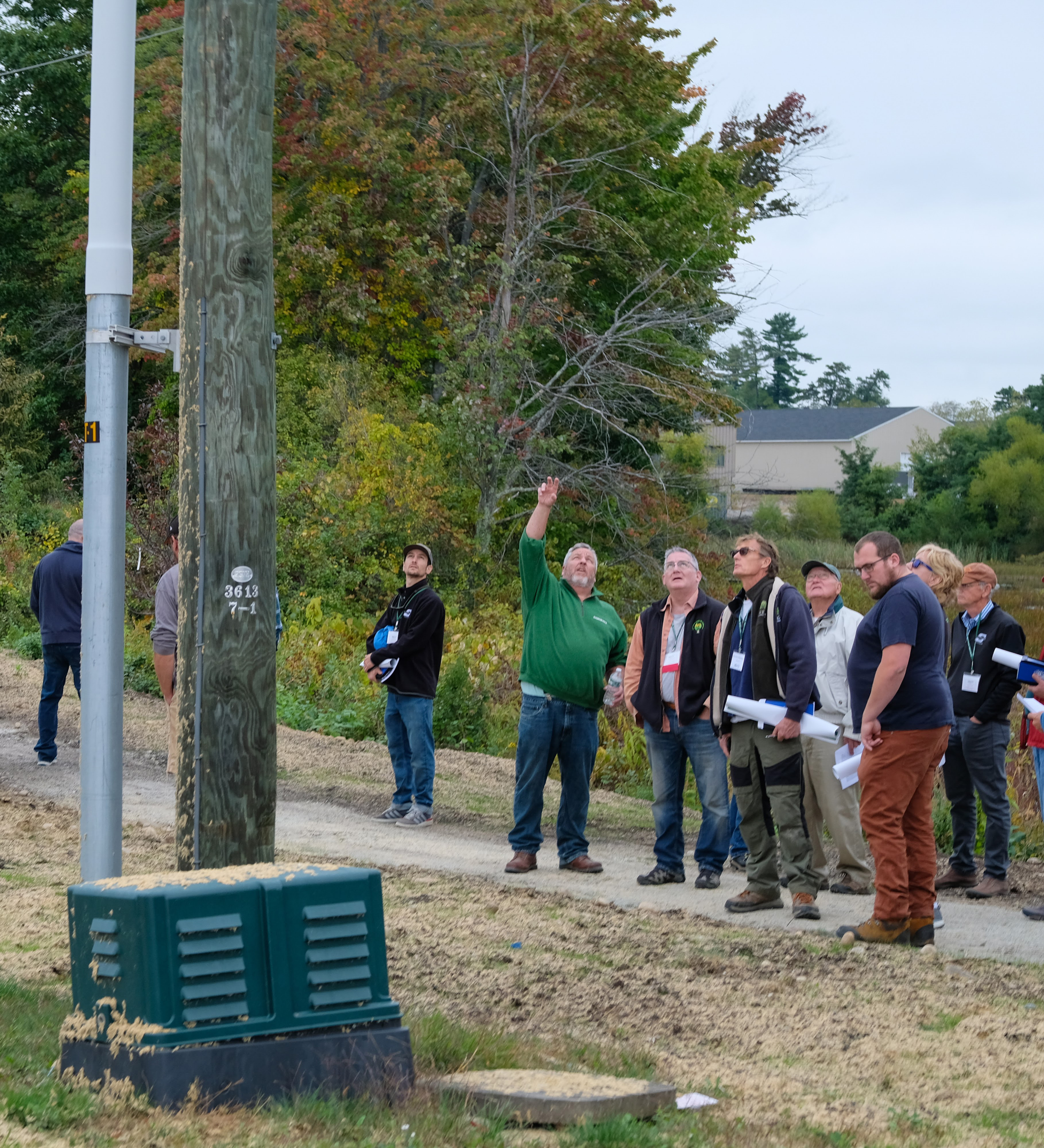
A crewman works to clear tree damage during the January storm that knocked out power to thousands of electric customers across New Hampshire. (Courtesy photo) Eversource, the state’s largest power utility, has 12,000 miles of overhead electric distribution lines to look after.
Looming over those lines are trees.
Some are white pines standing up to 120 feet tall, a lot of them aged and diseased. And, given the right weather conditions, those trees will topple, their branches will break off, threatening those lines and the electricity that lights our homes and powers our businesses.
Just as it happened in late January, when a winter storm of heavy wet snow took down trees and limbs, killing power to upwards of 100,000 customers in New England, some 80,000 Eversource customers in New Hampshire alone at its peak.
That’s where Eversource’s Bob Allen comes into the picture.
Allen is the utility’s manager of vegetation management, overseeing a team of arborists in New Hampshire and Massachusetts to maintain the trees and other vegetation around electric lines in more than 370 towns, doing what they can to mitigate the dangers from those aging trees. He’s been with the company for some 35 years, working first in Connecticut as a senior arborist.
His arrival in the Granite State coincided with the 2008 ice storm in December that downed trees and power lines, leaving more than 100,000 in the dark, some for several days.
“When you ask about other storms and comparing damage, that was really the grandfather of them all,” says Allen.
The January storm ranks right up there, with Allen describing the “snow loading” on the trees, in particular the conifers — the pine trees with their needles.
“The way that happened over a three-day period was the worst snow loading than anything I’ve ever seen,” says Allen. “The snow holds onto those needles.
Snow came in on Friday and then Sunday we had some wetter stuff — some got rain, some got freezing rain, some got sleet. And that turned to snow the next day on Monday. So we had a very hardened loading of snow on these branches.
It was a devastating storm and certainly from my experience, probably top five.”
According to Allen, 90 percent of all outages are caused by trees. The two contributing factors here are weather and the condition of the trees. New Hampshire’s trees, for the most part, are old — “mature,” as Allen calls them.
“Roadside forest is what we call the trees along the side of the road,” says Allen. “It’s a pretty mature forest at this point. When you get weather events, they can take a toll on a mature tree just like they could take a toll on a mature person.”
Several years of drought have weakened the trees, making them less hearty to fight off the disease of invasive insects.
“It’s a mature roadside forest,” he says.
“It is withstanding a lot of the problems that we’ve had, but there has been a cumulative effect on the general health of it.”

A white pine laden with heavy snow lays over a power line in Amherst during the January storm that, at its peak, cut power to about 80,000 Eversource customers. (Courtesy photo)
Cumulative effect
It is an issue that Doug Foley, Eversource’s New Hampshire president of electric operations, highlighted in a Jan. 25 statement, as more than 1,000 line, tree and service crews from New Hampshire, neighboring states and Canada worked to restore power across the state.
“Trees across New Hampshire are already incredibly stressed from the battering that they’ve been taking from our recent winter weather, as well as long-term cumulative impacts from droughts and invasive insects,” said Foley.
Behind Maine, New Hampshire is the second most forested state in the United States, with forests occupying 81 percent, or 4.8 million acres, according to the state Division of Forests and Lands. The 10 most abundant tree species, in order, are: red maple, white pine, hemlock, balsam fir, sugar maple, red oak, spruce, paper birch, yellow birch and beech.
The agency’s 2022 New Hampshire Forest Health Newsletter, released Dec. 22, 2022, reports 58,680 acres of insect damage last year, the most damage mapped in the past decade.
It said the largest damage-causing agent was the spongy moth, coming in at 52,532 acres of damage. Oaks are the spongy moth caterpillar’s favorite meal, but it will also consume beech, birch, elm, maples and most other hardwoods.
The next most extensive damage-causing agent was the hemlock looper, at 2,450 acres, followed by the balsam wooly adelgid at 1,826 acres.
According to the report, the Conway region was the most heavily impacted part of the state, with roughly 35,000 acres of mapped insect damage.
The agency also noted that most of New Hampshire experienced an abnormally dry summer in 2022, peaking at the end of August, leaving about a quarter of the state in severe drought and the southern region in extreme drought.
“By the end of summer, effects on the health of forests in the driest areas were becoming apparent as some trees, especially those on thin or sandy soils, had their leaves either drop prematurely or turn brown,” it said. “A return to normal precipitation during the fall months has since alleviated drought conditions throughout most of the state.”
It’s the cumulative effect that concerns Allen the most. “They’re going to see these diseases and insects and effects of the climate that change their health and change their ability to withstand things,” he says.
Weather can be an issue, no matter the season: Thunderstorms in the summer, hurricane winds in the fall, snow and ice in the winter, late winter storms in the spring. Allen says winds in excess of 40 mph can be a problem. And ice: a quarter inch of ice can generate enough load to start bringing trees and branches down, according to Allen.
Normally, during winter when leaves have fallen from the trees, wind is less of a factor. “They’re not going to act as a sail and might not break as easily because the wind can go through them,” he says. But bitter cold can make the wood more brittle, more prone to snapping under a heavy wind. And when the leaves repopulate the trees, “those summer and fall wind events can really cause a problem,” he adds.
Eastern white pine composes more than 500,000 acres of New Hampshire forestland. It is the second most abundant species in the state, behind the red maple, but it is the tallest tree that grows in the state. “I will tell you that they’re huge and they’re everywhere,” says Allen.

Bob Allen, in green shirt at center, Eversource’s manager of vegetation management, conducts a tour of the utility’s arboretum in Hooksett. (Courtesy photo)
Tree education
Eversource is proactive about trying to prevent tree damage to lines before it happens.
Allen says the utility’s workers cover about 2,500 miles of lines each year, contracting with tree crews to trim and remove potential dangers to the lines. In 2022 alone, the company announced an investment of approximately $35 million in tree trimming and hazardous tree removal.
It’s important to note that Eversource doesn’t own the trees along the roadsides, but they’ll take responsibility for mitigating damage to their lines.
“I’m not well versed on all the various corporations and businesses across the globe, but I don’t know if anybody else really invests in managing someone else’s assets to deliver their product reliably. We really don’t own a tree; we’re really managing somebody else’s tree,” says Allen.
Eversource also has two arboretums in New Hampshire — one in Hooksett and the other at the Urban Forestry Center in Portsmouth. The arboretums provide students, tree wardens, municipal officials, landscape architects and the public with examples of the wide variety of trees that can be safely planted near and under utility equipment.
Allen, past president of the NH Arborists Association, also does presentations to garden clubs.
The idea is to offer education on the types of trees that, when they grow to maturity, won’t impact overhead utility lines.
For homeowners, Eversource offers a poster, which it calls its “30 under 30” recommendations of 30 trees under 30 feet tall so they don’t impact overhead lines. The recommendations include such trees as certain varieties of maples, dogwoods, magnolias and arborvitae.
“We have all this natural beauty, and a part of our role is to balance the aesthetics while we’re increasing the reliability or maintaining the reliability of the line,” says Allen.